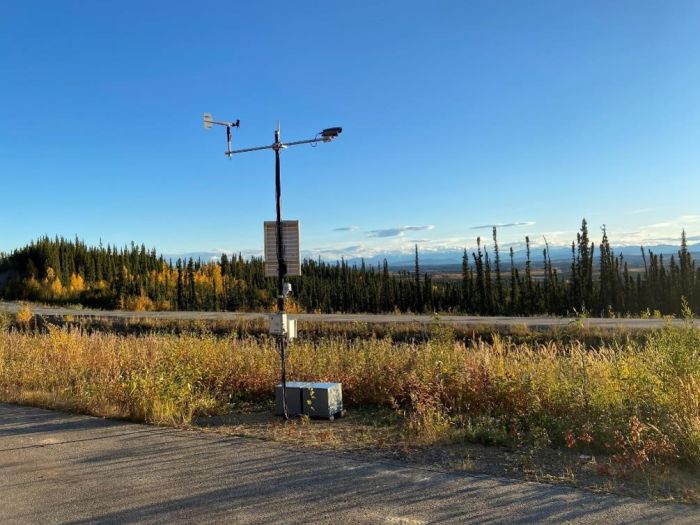


In 2019, Campbell Scientific entered a public/private partnership project with the Alaska Department of Transportation and Public Facilities (ADOT&PF) to demonstrate the scalable (mini) Road Weather Information System (RWIS) concept. This partnership included having research personnel from the University of Alaska Fairbanks (UAF) assess the performance of the Campbell Scientific mini-RWIS stations. The goal was to provide feedback to ADOT&PF regarding station performance and the feasibility of adding the mini-RWIS station concept as a cost-effective gap-filling option in the Alaskan RWIS network.
ADOT&PF manages approximately 70 RWIS stations and cameras along Alaska’s connected highway system. Due to lack of power infrastructure and/or lack of cellular communication, there are large gaps where no equipment or cameras can be installed based on the current RWIS system requirements. This is challenging for the maintenance operations decision-makers and limits the public notifications regarding roadway conditions. Adding more full RWIS sites is not only costly but requires a stable power source and working communications, which are currently unavailable. Campbell Scientific entered into a contract with ADOT&PF Design and Engineering Services (DES) to demonstrate the installation, testing, and overall effectiveness assessment of the Campbell Scientific mini-RWIS pilot project at eight sites specified by ADOT&PF.
Of the eight mini-RWIS initially conceived for this demonstration project, seven were successfully deployed at selected sites in the DOT Northern and South-Central regions. The eighth station was incorporated into a UAF project at Atigun Pass that was designed to provide data, forecasting, and warning for avalanche risks on the Dalton Highway. The system comprised multiple cameras, blowing snow sensors, and other atmospheric sensors on a solar panel/battery system.
This station at Atigun Pass should be considered a step above the mini-RWIS concept and is, by far, the northernmost advanced RWIS station deployed in the state of Alaska, providing data in an area where the climate conditions are extreme. As such, the station requirements were designed to withstand high winds, temperatures below -40oF, the potential for rime ice, two months without sunlight, and lack of cellular connectivity. To say the least, the location challenged the durability of the equipment.
Throughout the duration of the three-year project, the mini-RWIS concept proved to be greatly applicable in the state of Alaska where a traditional RWIS leaves large gaps of critically needed information. In addition, the imagery provided by the mini-RWIS stations can be used for ADOT&PF decision-making, as well as for public use. Atmospheric data collected from the Campbell Scientific mini-RWIS stations was accurate, reliable, and useful for maintenance personnel needs.
For more information about RWIS, visit our Road Weather Information Systems (RWIS) web page.
案例总结
应用
Supplementing an RWIS network with mini-RWIS stations位置
Alaska’s highway system参与机构
Alaska Department of Transportation and Public Facilities (ADOT&PF)测量参数
Road weather conditions, avalanche risks查看PDF